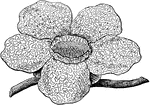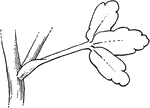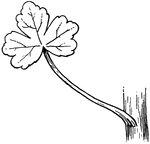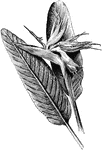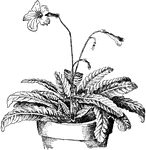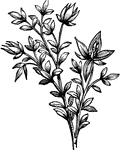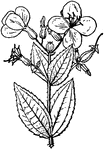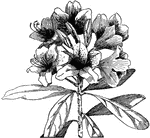143 illustrations of flowers and shrubs including: quassia, rafflesia, ragweed, ragwort, raspberry, rattle, rattlebox, rhododendron, rhodora, riverweed, rock-rose, rose, rosemary, rue, ruscus, and rush

Flowering Rush
A European plant which grows in stagnant or nearly stagnant water. It has long, sword-shaped leaves,…

Guelder Rose
Also known as the Snowball Tree, the Guelder Rose is a cultivated form of the genus Viburnum, especially…

Quassia
A genus in the family Simaroubaceae. Its size is disputed; some botanists treat it as consisting of…

Twig of Quince
Illustrated is a twig of common quince, cydonia oblonga. (a) and (b) shows where the fruit was borne.

Raceme
A flower cluster with the flowers stalked and comming off a commonand more or less elongated axis.
Raceme
A raceme, with a general peduncle, pedicels, bracts, and bractlets. Plainly the bracts here answer to…

Raceme
"Racemes.--When flowers are arranged round a filiform simple axis, each particular flower being stalked,…

Smilacina Racemosa
This flowering plant belongs to the ruscaceae, which are common in North America.

Ragged Robin
Ragged robin and cuckoo flower are the common names of lychnis flos-cuculi. The flowers are red or pink…
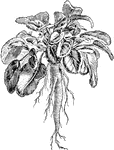
Rampion
Also known as Campanula rapunculus. "A hardy biennial, cultivated for the use of its fleshy roots in…
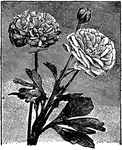
Ranunculus
"Ranunculus, buttercup, crowfoot; the typical genus of the order Ranunculaceæ. Known species about…

Garden Ranunculus
A large genus of about 600 species of plants, including buttercups and spearworts. They are mostly bright…

Raspberry Fertilization
"Raspberry (Rubus idaeus, order Rosaceae), being fertilized. A, Flower. p, p, Petals. a, a, Anthers.…

Yellow Rattle
Of the Figwort family (Scrophulariaceae), the yellow rattle (Rhinanthus Crista-Galli).

Red Campion
Red or morning campion are the common names of lychnis dioica. The flowers are normally red, varying…
Red Clover Root
Illustrated is the penetrating root of red clover. It is a fifteen month old plant that grew in hard…
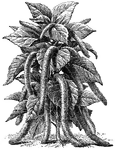
Red-Hot Cat-Tail
Red-Hot Cat-Tail is the common name of acalypha hispida. This shrub is cultivated for its long red spikes…
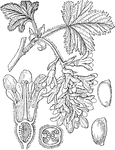
Redcurrant
"Ribes rubrum. 1. perpendicular section of a flower; 2. cross section of the ovary; 3. seed; 4. a perpendicular…

Redcurrant Raceme
"Raceme of common red currant. p, peduncle; p', pedicel; br, bract." -Bergen, 1896
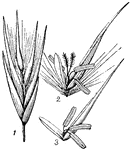
Reed
The common reed of the American and European reed swamps, growing from 5 to 12 feet high with leaves…
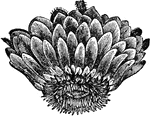
Victoria Regia
"Victoria Regia, named by Lindley after Queen Victoria, is the most magnificent of all known water lilies,…
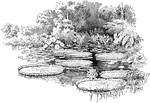
Victoria Regia
A species of flowering plants belonging to the Nymphaceaceae family, related to water lilies.

Trifolium Repens
This is a white clover, bearing pink flowers and glossy leaves. This flora is common the US.
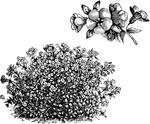
Polemonium Reptans
A flower that is native to eastern North American. It is either blue or white with leafy stems.
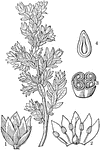
Rhabdia
"Rhabdia lycioides. 1. its flower; 2. the corolla opened; 3. a cross section of the ovary; 4. a perpendicular…

Rhipsalis Cassytha
Illustrated are tips of rhipsalis cassytha. Rhipsalis plants have habits similar to mistletoe. It grows…
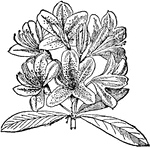
Rhododendeon
An extensive genus of shrubs of the heath family. The leaves are usually alternate and evergreen in…

Rhododendron
"Rhododendron pumilum; 1. a calyx and pistil, with all stamens removed; 2. an anther; 3. a ripe capsule…
Riverweed
"The female of Hydrostachys verruculosa. 1. the calyx; 2. the same opened to show the ovary; 3. a seed;…
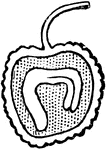
Seed of Rock Rose
Section of seed of Rock Rose, Helianthemum Canadense; orthotropus, with curved embryo in the albumen.

Rock-Rose
"A genus of exogenous plants, which gives its name to the natural order Cistaceae; an order allied to…




